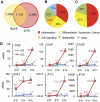Bcl-6 and NF-kappaB cistromes mediate opposing regulation of the innate immune response
- PMID: 21106671
- PMCID: PMC3003193
- DOI: 10.1101/gad.1998010
Bcl-6 and NF-kappaB cistromes mediate opposing regulation of the innate immune response
Abstract
In the macrophage, toll-like receptors (TLRs) are key sensors that trigger signaling cascades to activate inflammatory programs via the NF-κB gene network. However, the genomic network targeted by TLR/NF-κB activation and the molecular basis by which it is restrained to terminate activation and re-establish quiescence is poorly understood. Here, using chromatin immunoprecipitation sequencing (ChIP-seq), we define the NF-κB cistrome, which is comprised of 31,070 cis-acting binding sites responsive to lipopolysaccharide (LPS)-induced signaling. In addition, we demonstrate that the transcriptional repressor B-cell lymphoma 6 (Bcl-6) regulates nearly a third of the Tlr4-regulated transcriptome, and that 90% of the Bcl-6 cistrome is collapsed following Tlr4 activation. Bcl-6-deficient macrophages are acutely hypersensitive to LPS and, using comparative ChIP-seq analyses, we found that the Bcl-6 and NF-κB cistromes intersect, within nucleosomal distance, at nearly half of Bcl-6-binding sites in stimulated macrophages to promote opposing epigenetic modifications of the local chromatin. These results reveal a genomic strategy for controlling the innate immune response in which repressive and inductive cistromes establish a dynamic balance between macrophage quiescence and activation via epigenetically marked cis-regulatory elements.
Figures




References
-
- Barish GD, Downes M, Alaynick WA, Yu RT, Ocampo CB, Bookout AL, Mangelsdorf DJ, Evans RM 2005. A nuclear receptor atlas: Macrophage activation. Mol Endocrinol 19: 2466–2477 - PubMed
-
- Bereshchenko OR, Gu W, Dalla-Favera R 2002. Acetylation inactivates the transcriptional repressor BCL6. Nat Genet 32: 606–613 - PubMed
-
- Charo IF, Ransohoff RM 2006. The many roles of chemokines and chemokine receptors in inflammation. N Engl J Med 354: 610–621 - PubMed
Publication types
MeSH terms
Substances
Grants and funding
- R37DK057978/DK/NIDDK NIH HHS/United States
- R01 HD027183/HD/NICHD NIH HHS/United States
- K08 HL092298/HL/NHLBI NIH HHS/United States
- U19DK062434/DK/NIDDK NIH HHS/United States
- P30 DK063491/DK/NIDDK NIH HHS/United States
- HHMI/Howard Hughes Medical Institute/United States
- R01HL086566/HL/NHLBI NIH HHS/United States
- P30DK063491/DK/NIDDK NIH HHS/United States
- R37 DK057978/DK/NIDDK NIH HHS/United States
- R01 HL086566/HL/NHLBI NIH HHS/United States
- R01HD027183/HD/NICHD NIH HHS/United States
- P01 HL088093/HL/NHLBI NIH HHS/United States
- 1K08HL092298/HL/NHLBI NIH HHS/United States
- U19 DK062434/DK/NIDDK NIH HHS/United States
- P01HL088093/HL/NHLBI NIH HHS/United States
LinkOut - more resources
Full Text Sources
Other Literature Sources
Molecular Biology Databases
